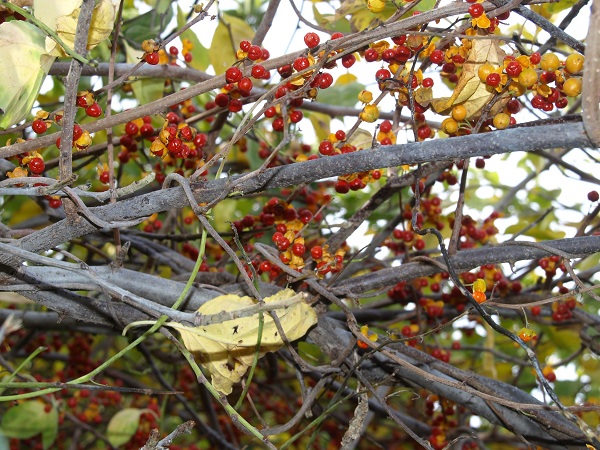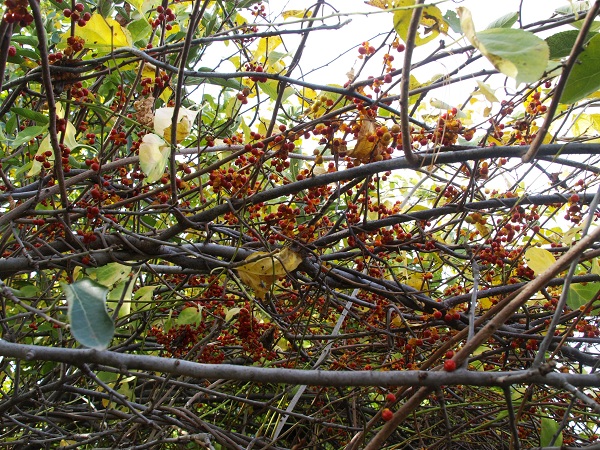Commercial culture info on Bittersweet:
If you are a commercial grower of berries or wreathes, and are looking for a market, supply us with your contact information. We will pass it along to customers requesting sprigs, branches, and wreathes. Of course, preference is given to those who purchased their plants from us!
Commercial production of fruited branches and/or wreathes.
The market for Bittersweet in the floral and craft trades is way under-supplied! We recently saw (September 2012) Bittersweet sprigs selling at a craft show for $25.00 per three 12″ sprigs………….And they were selling fast! A 12″ diameter ‘grown-in-place’ wreath was selling for $55.00………..While they lasted.
The culture for commercial production is a little different from landscape culture. More attention must be given towards training and pruning……….Especially in the first few years. Don’t expect any harvest the first year and only a small one the second year. These take time to get established and will reach full production in four years.
Have an idea of what type of market you are targeting. Berry forms are different between the three types of Bittersweet (Evergreen bittersweet is not suitable for commercial production). Read below for the differences and also learn about the third Bittersweet that is newer on the market and does not require male and female plants.
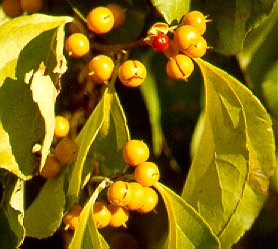
Late summer above
Best for marketing:
What is your market?
- Berry clusters at tips only: (Used in craft and floral designs. Berries tend to stay firmly on the vine)
- Celastrus Scandens (American)
- Autumn Revolution (American)
- Berries along stems and tips: (Used as fall decorations, wreath decorations, and some flower arrangements. Berries may fall off over time (3-6 months)
- Celastrus orbiculatus (Chinese or Oriental) Very invasive and not recommended. We do not grow this variety. Prohibited in some States.
- Celastrus angulatus (Chinese Staff Vine) Brighter, more vermillion berries, but more difficult to manage. Available as seed only.
- Celastrus loeseneri (Asain Bittersweet) Berries “shatter” easily when dry. Can be invasive. we do not grow this variety.
Decorative branches:
- Celastrus Scandens
- Celastrus angulatus (Also known as Chinese Staff Vine)
For “grown-in-place” wreathes:
- Celastrus angulatus
- Celastrus scandens
Ability for berries to “hold” on branches:
- Celastrus Scandens
Fastest growth:
- Celastrus loeseneri
- Celastrus scandens
Sturdiest growth:
- Celastrus Scandens
So, it depends on what your target market is. Scandens is American Bittersweet and Orbiculatus is Chinese or Oriental Bittersweet. Celastrus Angulatus is another member of the Bittersweet family and is commonly called Chinese staff Vine. Oriental bittersweet can be invasive due to it’s rapid growth, BTW. That is also what makes it best for wreathes and twisted, twining branches. However, the end result of it spreading everywhere out-weighs any good points about it! A better choice is Celastrus scandens as it has the rapid growth, but is not invasive as is orbiculatus. Evergreen Bittersweet is not suitable for the commercial craft market as the leaves look horrible after a few days and the berries will drop almost immediately.
The different strains of Bittersweet are said to cross-pollinate, but not easily. We have tried several “crosses”. This can be good or bad. We have one “hybrid” that has yet to flower after 5 years. We have one with purple edges on the leaves, but it does not bloom and tends to scorch in the sun.. These are just a few of the crosses that I have kept to see what they will do. So far, I’m not impressed with the above hybrids. However, there is ONE plant that is a scandens x loeseneri cross that we thought had potential. It is a female and bears very heavy crops of berries. They just aren’t on the outer branches where one could market them. The success with deliberate cross pollination has been less than 1%. The very tiny blooms also make this difficult. Maybe we could hire some well-trained bees to do this task……………………..
Autumn Revolution is fairly new on the market. This variety does not require separate male and female vines and is self pollinating. It was discovered by Bailey Nurseries and is patented, hence the higher cost per plant.
Growing:
- Best PH is 6-7.0
- Full sun is a must for commercial production.
- Well drained soil; sandy loam is best if rich with organic matter. We are on Mississippi river-bottom land (prehistoric river-bottom…….Back when the river was much larger!) which is excellent for just about everything; especially weeds!
- A balanced fertility will produce the most fruit, especially if high in phosphorus during bud set. Use of a “blossom booster” such as sold by Peter’s in early spring will increase bloom. Excessive nitrogen will result in very rampant growth which is useful only if growing wreathes as this growth usually will not survive a winter. Fruit set is also sacrificed.
- Balanced moisture…………..Such as 1 inch of rainfall or irrigation per week.
Pollination:
- DO NOT SPRAY VINES IN SPRING WITH INSECTICIDES! Bees are responsible for pollination!!!
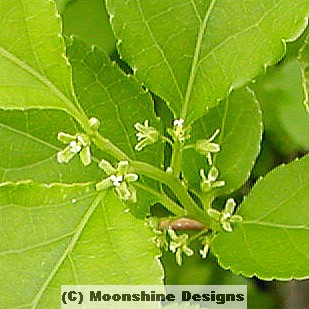
Male blooms above
Female below
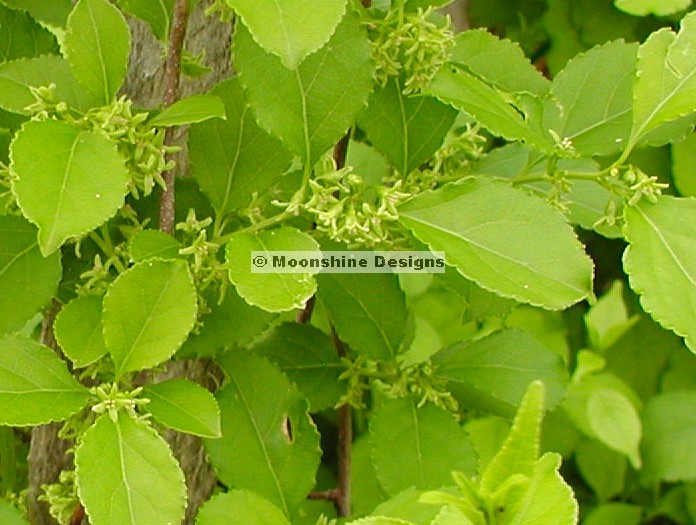
Some say that Bittersweet is self-pollinating. And, while there are hermaphroditic (both sexes on the same plant) plants, they are few and far between. There are male and female plants. Both may bear fruit, but the female will bear heavily provided the male is present and within 100 feet for best results. Figure 1 male for every five females. If you are purchasing the large seed-grown wholesale lots, then the plants are of mixed sex. Male plants can be used to form wreathes and twisted branches; saving the females for berry harvest. The mix will not be 50/50 as there tends to be more female plants than male plants from seed. About 60/40.
Some plants from seed are hermaphroditic; producing both male & female flowers on the same vine. Very rare, but it happens. Berry set is not as heavy as a true female plant. Autumn Revolution is an exception.
Plants propagated from cuttings are always the same sex as the parent plant.
Spacing:
- Space plants which are to be used strictly to form wreathes 12 to 18 inches apart. For berry, wreath, and/or branch production, 36-48”.
Supports:
- Grow along a stout fence or supply three support wires in a horizontal fashion 12”, 36”, and 60” apart. Set minimum 4” diameter posts a maximum 10’ apart and set base 3’ deep. #9 wire is recommended for horizontal supports. Use of a turnbuckle at one end will enable you to tighten the wire when it sags. This may sound like a lot, but these vines get heavy!
Mulching:
- All seedlings and transplants under three years should be mulched in the fall with grass clippings, straw, shredded bark, or leaves. Mulching in the future will also prevent weed growth and conserve soil moisture. Beware of munching rodents and rabbits in the winter!
Training Vines
- If you have the seedlings or one year vines, a simple 6’ vertical stake or string is all that’s needed the first year.
- From then on, a suitable fence, or the above described arbor will be necessary.
- Second year or 2 year container vines: Train the vine straight up to the lowest wire, keeping the main trunk straight. We have pruned the top of larger vines and they will produce lateral branches that should be trained horizontal as they develop.
- Tying is not necessary once the initial training has begun as they will naturally twist themselves around just about everything (Keep that in mind if planted adjacent to other plants!). They will also twist around each other, so you have to keep an eye on them as the season progresses to train them for the best market appearance.
- Don’t be afraid to prune or shape any time. Just keep in mind that berries are produced on one year and older wood. The heaviest set is on two-three year old wood. As the branches age, production will fall, so heavy pruning every so often in early spring or late fall will increase over-all production. Old wood should be pruned out to allow for new growth to take it’s place.
- Pruning or pinching the ends of branches will also result in more laterals along the stems. Don’t prune off the berries! This extra pruning is especially important if producing decorative shapes such as hearts or wreathes.
- Prune as necessary to keep them within bounds. Best pruning time is November to March, but they can be pruned almost anytime. Blooming vines can be trained into a wreath shape for harvest after the first frost. Keep the wreath to 24” or less if not supported individually or they may distort…….No, actually they WILL distort!
Some other notes:
- Flowers, while not conspicuous, are very fragrant. To the point of wickedly sweet if you are around a large number of them.
- Remember! Bees and butterflies are necessary for pollination.
- Do not allow the vines to become so dense that the blooms are hidden to the point where they are over-looked by the bees.
- All parts of the plant are poisonous, but not to the point of being lethal. Still, don’t eat them!
- A frost or drying is necessary to open the seed capsules. This can also be done artificially by placing the sprigs in the freezer overnight to capture the early market.
- Watch that the birds don’t get the berries before you do. They like them too. Netting can be used to exclude them if necessary.
- Bears also like the berries, but that is not a problem where we are.
- Deer do not usually bother bittersweet. They will, however, eat about anything under severe conditions.
- Mice and voles also like these berries.
Pests:
- Very few. Even the Japanese Beetles don’t bother these vines. Aphids can affect new growth in the early spring, but ladybugs usually take care of that problem pretty quick.
- Rabbits. In the winter, when there is a snow cover and little for these fur balls to eat, they will eat the bark around the branches right at the snow line. This will kill the upper portion of the branch above this girdling. If you like wild rabbit on the dinner table, that is an effective control. Otherwise, use a repellant spray or chicken wire. Once the plants are 5 years old or more, the rabbits will not bother the older lower growth.
Diseases:
- None that I know of other than occasional damp-off in the seedling stage caused by over-watering.
Harvest:
- Cut the sprigs as needed either after a frost or freeze them yourself. Sprigs should be about 12″ or longer unless you have a specific market for shorter lengths.
- Leaving the leaves on is a good selling point at local markets, but they will eventually fall off.
- Harvesting for shipment. Cut sprigs before the capsules open. Do not dry or freeze. The end user will need to dry the branches to open the capsules. Sprigs with open capsules will “shatter” in shipment.
- Do not try to ship dried bittersweet. It just doesn’t work as the berries will shatter and fall off in transit. Ship fresh-cut only and do not pack it too tightly.
- Harvest wreathes by cutting back the branches used to make the shape. Leave them long so that they can be used to secure other items or berries to the shape. Watch for hidden critters in the wreath! By the time you are harvesting, those critters are looking for a place to spend the winter!
Drying:
- Cool, dry, well ventilated area. Avoid warm, moist areas or you will have mold.
- Make sure your curing/storage area is rodent-proof. A couple of mice can strip off an enormous number of berries in short order!
Best market time for shapes and berried sprigs is late September thru December with November usually being the ‘hottest’ month for sales.
Footnote: We do not grow Bittersweet for the floral or craft-supply market. Our stock plants are used to propagate more plants for sale. We will be happy to answer any questions about growing (Roger) and decorating (Wanda), but we will not market it for you nor purchase your crop. If you are a commercial grower or are considering becoming one, we can forward requests to you as we get requests from time to time by business owners looking for producers. This offer is for our customers only! However, we take no responsibility as to the suitability of that contact for your specific purposes.
Photos below are from fall 2012 on ten year old stock plants (female)

